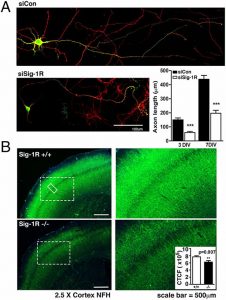 Dysregulation of cyclin-dependent kinase 5 (cdk5) per relative concentrations of its activators p35 and p25 is implicated in neurodegenerative diseases. P35 has a short t(1/2) and undergoes rapid proteasomal degradation in its membrane-bound myristoylated form. P35 is converted by calpain to p25, which, along with an extended t(1/2), promotes aberrant activation of cdk5 and causes abnormal hyperphosphorylation of tau, thus leading to the formation of neurofibrillary tangles. The sigma-1 receptor (Sig-1R) is an endoplasmic reticulum chaperone that is implicated in neuronal survival. However, the specific role of the Sig-1R in neurodegeneration is unclear. Here we found that Sig-1Rs regulate proper tau phosphorylation and axon extension by promoting p35 turnover through the receptor’s interaction with myristic acid. In Sig-1R-KO neurons, a greater accumulation of p35 is seen, which results from neither elevated transcription of p35 nor disrupted calpain activity, but rather to the slower degradation of p35. In contrast, Sig-1R overexpression causes a decrease of p35. Sig-1R-KO neurons exhibit shorter axons with lower densities. Myristic acid is found here to bind Sig-1R as an agonist that causes the dissociation of Sig-1R from its cognate partner binding immunoglobulin protein. Remarkably, treatment of Sig-1R-KO neurons with exogenous myristic acid mitigates p35 accumulation, diminishes tau phosphorylation, and restores axon elongation. Our results define the involvement of Sig-1Rs in neurodegeneration and provide a mechanistic explanation that Sig-1Rs help maintain proper tau phosphorylation by potentially carrying and providing myristic acid to p35 for enhanced p35 degradation to circumvent the formation of overreactive cdk5/p25.
Dysregulation of cyclin-dependent kinase 5 (cdk5) per relative concentrations of its activators p35 and p25 is implicated in neurodegenerative diseases. P35 has a short t(1/2) and undergoes rapid proteasomal degradation in its membrane-bound myristoylated form. P35 is converted by calpain to p25, which, along with an extended t(1/2), promotes aberrant activation of cdk5 and causes abnormal hyperphosphorylation of tau, thus leading to the formation of neurofibrillary tangles. The sigma-1 receptor (Sig-1R) is an endoplasmic reticulum chaperone that is implicated in neuronal survival. However, the specific role of the Sig-1R in neurodegeneration is unclear. Here we found that Sig-1Rs regulate proper tau phosphorylation and axon extension by promoting p35 turnover through the receptor’s interaction with myristic acid. In Sig-1R-KO neurons, a greater accumulation of p35 is seen, which results from neither elevated transcription of p35 nor disrupted calpain activity, but rather to the slower degradation of p35. In contrast, Sig-1R overexpression causes a decrease of p35. Sig-1R-KO neurons exhibit shorter axons with lower densities. Myristic acid is found here to bind Sig-1R as an agonist that causes the dissociation of Sig-1R from its cognate partner binding immunoglobulin protein. Remarkably, treatment of Sig-1R-KO neurons with exogenous myristic acid mitigates p35 accumulation, diminishes tau phosphorylation, and restores axon elongation. Our results define the involvement of Sig-1Rs in neurodegeneration and provide a mechanistic explanation that Sig-1Rs help maintain proper tau phosphorylation by potentially carrying and providing myristic acid to p35 for enhanced p35 degradation to circumvent the formation of overreactive cdk5/p25.
Hot Off the Press! – May 2015
Sigma-1 receptor regulates Tau phosphorylation and axon extension by shaping p35 turnover via myristic acid. Journal Article
In: Proc Natl Acad Sci U S A, vol. 112, no. 21, pp. 6742–6747, 2015, ISSN: 1091-6490 (Electronic); 0027-8424 (Linking).
